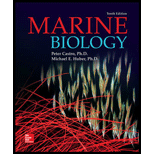
Some biologists place the seaweeds in the kingdom Plantae; others consider seaweeds to be protists. Assume that a better arrangement is to group the green, brown, and red algae in their own kingdom, which we will call Macrophyta. Characterize the new kingdom by first giving its unique characteristics and then differentiate it from the protists and the true plants. Be sure to consider major exceptions or overlaps.
To characterize: The unique characteristics of new kingdom Macrophyta and differentiate it from the protists and the true plants.
Introduction: Many fascinating photosynthetic organisms that have evolved from terrestrial vascular plants populate the ocean and marine environment. They carry many morphological features that originally suit with the adaptations to terrestrial plants. However, they are not the members of the Kingdom Plantae.
Explanation of Solution
A unique feature of protists is that they share some functional and anatomical features that are common to both plants and animals. They are eukaryotic, but most of them are unicellular or they are syncytial and some are multicellular.
The unicellular algae are primarily placed under Kingdom Protista, but now they are grouped under Kingdom Plantae as they possess similarities to the green algae. However, the marine algal forms like seaweeds (green, brown, red algae) can be grouped into a hypothetical kingdom called Macrophyta.
The unique characteristics of new kingdom Macrophyta:
- The hypothetical kingdom Macrophyta consists of organisms that are eukaryotic and mostly multicellular.
- It also consists of some unicellular forms and some with multinucleated thallus.
- All of them are autotrophs (except some specialized parasites that can carry out photosynthesis and synthesize complex carbohydrates by trappings energy from sunlight).
- It can reproduce by both sexual and asexual modes of reproduction.
Differentiation of Kingdom Macrophyta from protists and true plants:
- 1. Kingdom Protista consists of eukaryotes, but unicellular organism and many of protists are heterotrophs. Macrophytes contain unicellular, multicellular as well as thalloid forms, and all are autotrophs (except some specialized parasites).
- 2. Except some specialized parasites, all Macrophytes are autotrophs like the plants. However, the Macrophytes lack the complex morphology (true leaves, stem, and root) and well reproductive system as plants.
Want to see more full solutions like this?
Chapter 6 Solutions
Marine Biology (Botany, Zoology, Ecology and Evolution)
- students in a science class investiged the conditions under which corn seeds would germinate most successfully. BAsed on the results which of these factors appears most important for successful corn seed germination.arrow_forwardI want to write the given physician orders in the kardex formarrow_forwardAmino Acid Coclow TABle 3' Gly Phe Leu (G) (F) (L) 3- Val (V) Arg (R) Ser (S) Ala (A) Lys (K) CAG G Glu Asp (E) (D) Ser (S) CCCAGUCAGUCAGUCAG 0204 C U A G C Asn (N) G 4 A AGU C GU (5) AC C UGA A G5 C CUGACUGACUGACUGAC Thr (T) Met (M) lle £€ (1) U 4 G Tyr Σε (Y) U Cys (C) C A G Trp (W) 3' U C A Leu בוט His Pro (P) ££ (H) Gin (Q) Arg 흐름 (R) (L) Start Stop 8. Transcription and Translation Practice: (Video 10-1 and 10-2) A. Below is the sense strand of a DNA gene. Using the sense strand, create the antisense DNA strand and label the 5' and 3' ends. B. Use the antisense strand that you create in part A as a template to create the mRNA transcript of the gene and label the 5' and 3' ends. C. Translate the mRNA you produced in part B into the polypeptide sequence making sure to follow all the rules of translation. 5'-AGCATGACTAATAGTTGTTGAGCTGTC-3' (sense strand) 4arrow_forward
- What is the structure and function of Eukaryotic cells, including their organelles? How are Eukaryotic cells different than Prokaryotic cells, in terms of evolution which form of the cell might have came first? How do Eukaryotic cells become malignant (cancerous)?arrow_forwardWhat are the roles of DNA and proteins inside of the cell? What are the building blocks or molecular components of the DNA and proteins? How are proteins produced within the cell? What connection is there between DNA, proteins, and the cell cycle? What is the relationship between DNA, proteins, and Cancer?arrow_forwardWhy cells go through various types of cell division and how eukaryotic cells control cell growth through the cell cycle control system?arrow_forward
 Biology (MindTap Course List)BiologyISBN:9781337392938Author:Eldra Solomon, Charles Martin, Diana W. Martin, Linda R. BergPublisher:Cengage Learning
Biology (MindTap Course List)BiologyISBN:9781337392938Author:Eldra Solomon, Charles Martin, Diana W. Martin, Linda R. BergPublisher:Cengage Learning Biology Today and Tomorrow without Physiology (Mi...BiologyISBN:9781305117396Author:Cecie Starr, Christine Evers, Lisa StarrPublisher:Cengage Learning
Biology Today and Tomorrow without Physiology (Mi...BiologyISBN:9781305117396Author:Cecie Starr, Christine Evers, Lisa StarrPublisher:Cengage Learning
 Biology: The Dynamic Science (MindTap Course List)BiologyISBN:9781305389892Author:Peter J. Russell, Paul E. Hertz, Beverly McMillanPublisher:Cengage Learning
Biology: The Dynamic Science (MindTap Course List)BiologyISBN:9781305389892Author:Peter J. Russell, Paul E. Hertz, Beverly McMillanPublisher:Cengage Learning Concepts of BiologyBiologyISBN:9781938168116Author:Samantha Fowler, Rebecca Roush, James WisePublisher:OpenStax College
Concepts of BiologyBiologyISBN:9781938168116Author:Samantha Fowler, Rebecca Roush, James WisePublisher:OpenStax College Biology: The Unity and Diversity of Life (MindTap...BiologyISBN:9781305073951Author:Cecie Starr, Ralph Taggart, Christine Evers, Lisa StarrPublisher:Cengage Learning
Biology: The Unity and Diversity of Life (MindTap...BiologyISBN:9781305073951Author:Cecie Starr, Ralph Taggart, Christine Evers, Lisa StarrPublisher:Cengage Learning





